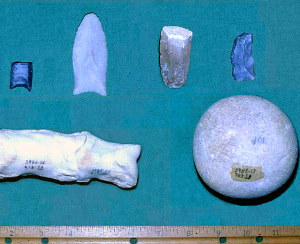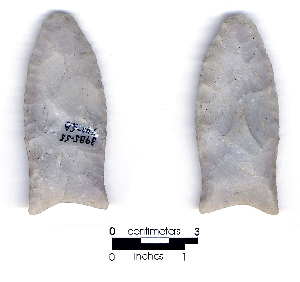Sub-Stratum 5A: Lower member—clean cave fill
This stratum is a fine-grained, “clean” cave deposit formed from the decay of the limestone shelter. The term “clean” is used to convey, in a relative sense, that the deposit was not dirtied by a great deal of human occupation. However, a few hundred pieces of debris and artifacts were found, several of which are important chronological indicators of an early Paleoindian occupation. These include the base sections of two Folsom projectile points and, at a lower level, a waisted, unfluted lanceolate dart point. An end scraper, utilized flake, and round quartzite cobble also were recovered from this stratum. Bones included the second and third phalanges (toe bones) of a now-extinct bison. There was some evidence of a fire hearth in this stratum at the level of the Folsom bases.
The unfluted lanceolate point has a slightly expanded haft and concave basal area which has been thinned on one face by a series of flake removals. Lateral haft edges and concavity are moderately ground. Made from a nonlocal, opaque, whitish-gray material resembling novaculite, the specimen has an overall rounded, almost polished feel. Paleoindian archeologist Michael Collins notes that this material, a possible Paleozoic chert, apparently produces very rounded flake scars when knapped, almost as if it were stream-rolled or ground. This differs significantly from Edwards chert which produces more angular ridges when flaked. The point has an maximum overall length of 71.7 mm, width of 30.25, and thickness of 9.4. Basal width is 29.7 mm.
Although this specimen has been described as an unfluted, waisted Clovis, it also has been likened to type Suwannee, which may postdate Clovis. The Suwannee homeland, however, is some 800 miles away in the southeastern United States, with particular focus in Florida.
The circular quartzite cobble was found in the same excavation unit and at roughly the same elevation as the point. The cobble is slightly polished on one side, as if from carrying and handling.
Both the Folsom bases and utilized flake were made on a black, fine-grained chert. These points were found some 3-6 inches higher than the unfluted lanceolate, in a nearby excavation unit. Maximum width of the base shown in the photo is 18.3 mm and thickness, 4.6 mm; lateral edges are heavily ground.

|

|